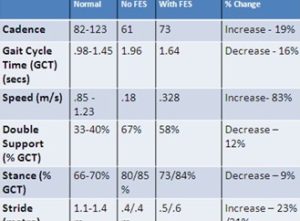
Individuals with a diagnosis of hemiplegia (from stroke or acquired brain injury) or multiple sclerosis or incomplete spinal cord injury can all benefit from FES (functional electrical stimulation) and it should be considered when gait restoration or improvement is a clinical goal. As the presentation of motor loss in stroke vs MS vs SCI is different the clinical assessment and outcome measures therefore need to be appropriate for the diagnosis.
In stroke use of the Functional Walking Category (Perry & Garrett) vs the Kurtzke Expanded Disability Status Scale (EDSS) in MS vs the ASIA Impairment Scale, AIS or Ambulatory Motor Index (American Spinal Injuries Association) in incomplete SCI ensure accurate baseline categorization of the patient’s walking ability and objective quantification of change with FES.
Measurements of the effect of FES that can be employed in all three diagnoses include walking speed over 10 metres and gait analysis, specifically stride length measurement, cadence and foot strike angle.
Use of Outcome & Assessment measures when intervening w/ FES for a particular diagnosis allows:
}identification of a particular diagnostic feature that can be addressed w/ NMES/FES
}Helps to establish a prognosis w/ use of FES
}Allows tracking of treatment efficacy
}Assists w/ clinical research and data
} Assists w/ service effectiveness audits, service provision & quality management
}May assist w/ patient communication & establishment of Rx goals
Post a Comment